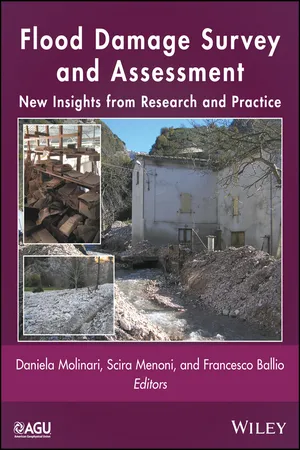
Flood Damage Survey and Assessment
New Insights from Research and Practice
- English
- ePUB (mobile friendly)
- Available on iOS & Android
Flood Damage Survey and Assessment
New Insights from Research and Practice
About This Book
Floods can have a devastating impact on life, property and economic resources. However, the systematic collection of damage data in the aftermath of flood events can contribute to future risk mitigation. Such data can support a variety of actions including the identification of priorities for intervention during emergencies, the creation of complete event scenarios to tailor risk mitigation strategies, the definition of victim compensation schemes, and the validation of damage models to feed cost-benefit analysis of mitigation actions.
Volume highlights include:
- Compilation of real world case studies elaborating on the survey experiences and best practices associated with flood damage data collection, storage and analysis, that can help strategize flood risk mitigation in an efficient manner
- Coverage of different flooding phenomena such as riverine and mountain floods, spatial analysis from local to global scales, and stakeholder perspectives, e.g. public decision makers, researchers, private companies
- Contributions from leading experts in the field, researchers and practitioners, including civil protection actors working at different spatial and administrative level, insurers, and professionals working in the field of natural hazard risks mitigation
Flood Damage Survey and Assessment: New Insights from Research and Practice will be a valuable resource for earth scientists, hydrologists, meteorologists, geologists, geographers, civil engineers, insurers, policy makers, and planners.
Read an interview with the editors to find out more:
https://eos.org/editors-vox/the-value-of-disaster-damage-data
Frequently asked questions
Information
Part I
Introduction
1
Overview of the United Nations Global Loss Data Collection Initiative
ABSTRACT
The Year 2015 was marked by the emergence of three international agreements: The Sendai Framework for Disaster Risk Reduction, the 2030 Agenda for Sustainable Development, and in the Intergovernmental Panel on Climate Change (IPCC) Conference of the Parties (COP) 2015, a global legally binding agreement on Climate Change now known as the Paris Agreement.All of these frameworks explicitly recognize the importance and usefulness of collecting and analyzing loss data in their corresponding implementations. The Sendai Framework, in particular, calls for the collection of data about disaster of all scales. It also calls for the collection of data about man‐made, technological, environmental, and other hazards, with an emphasis on climate‐related risks.Most importantly, the Sendai Framework sets out seven targets, of which four relate to losses: mortality, people affected, economic loss, and damages to infrastructure. This implies that the coverage of national disaster loss data sets will have to be expanded to be global so that countries can report on these targets. This development represents a unique opportunity to build a bottom‐up constructed global disaster loss database.Many actors have collected national loss data for many years. For over a decade, the United Nations (UN) system has supported and promoted the construction of national disaster databases based on the Disaster Information Management System (DesInventar) methodology and software tools. Additionally, a number of countries have been collecting data with proprietary specifications and different levels of resolution. These include several countries that collect data at a localized level, for example, European countries where data are associated with compensation mechanisms.DesInventar‐based national data sets also cover small disasters, breaking down event data by municipality aggregates and using a rich set of indicators, which contain those that will be required to report against the Sendai Framework. The number of indicators implies bigger efforts may be required to build or retrofit and sustain these databases, which in addition can provide a clearer picture of damage trends and patterns at sub‐national scales and contribute to a better understanding of risk.There are, however, methodological, conceptual, and practical challenges associated with a relatively localized data collection. These challenges may range from discrepancies in the perception of what an “event” is, to difficulties in the integration of multiple data sources, to the additional effort required to disaggregate information collected otherwise and the challenge of the economic valuation of the damage aggregates using a consistent and homogeneous methodology.Despite these challenges, the 2015 edition of the Global Assessment Report on Disaster Risk Reduction (GAR) by the UN features analyses using a consolidated, homogenized, and standardized data set covering 82 countries and several states in India, which includes a uniform economic valuation of damage. The United Nations Office for Disaster Risk Reduction (United Nations International Strategy for Disaster Reduction [UNISDR]) has been using this data set as a proof of concept of what a global database could look like. The UN Initiative, which started in 2005 when only 15 countries had these data sets, has continued to approach 100 countries in 2015. It will continue with renewed enthusiasm in the next few years, with the target of global coverage by 2020, as stated by the Sendai Framework.
1.1. DISASTER RISK REDUCTION: A FRAMEWORK FOR ACTION
1.2. THE SENDAI AND OTHER FRAMEWORKS OF 2015
1.3. THE SENDAI FRAMEWORK AND LOSS DATA COLLECTION
Table of contents
- COVER
- TITLE PAGE
- TABLE OF CONTENTS
- CONTRIBUTORS
- PREFACE
- ACKNOWLEDGMENTS
- Part I: Introduction
- Part II: Data Storage
- Part III: Data Collection
- Part IV: Data Analysis
- Part V: Information and Communication Technology Tools
- Conclusions
- INDEX
- END USER LICENSE AGREEMENT